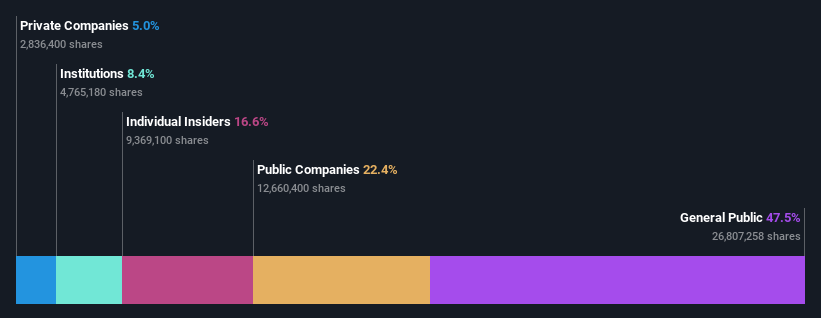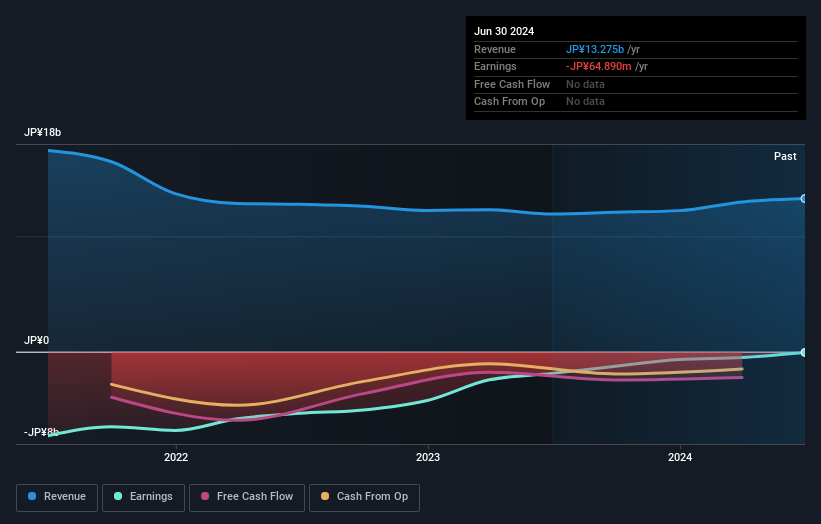- Japan
- /
- Interactive Media and Services
- /
- TSE:2440
Gurunavi, Inc.'s (TSE:2440) stock price dropped 10% last week; individual investors would not be happy

Key Insights
- Significant control over Gurunavi by individual investors implies that the general public has more power to influence management and governance-related decisions
- The top 10 shareholders own 51% of the company
- 17% of Gurunavi is held by insiders
If you want to know who really controls Gurunavi, Inc. (TSE:2440), then you'll have to look at the makeup of its share registry. And the group that holds the biggest piece of the pie are individual investors with 47% ownership. Put another way, the group faces the maximum upside potential (or downside risk).
And following last week's 10% decline in share price, individual investors suffered the most losses.
Let's take a closer look to see what the different types of shareholders can tell us about Gurunavi.
See our latest analysis for Gurunavi

What Does The Institutional Ownership Tell Us About Gurunavi?
Institutional investors commonly compare their own returns to the returns of a commonly followed index. So they generally do consider buying larger companies that are included in the relevant benchmark index.
We can see that Gurunavi does have institutional investors; and they hold a good portion of the company's stock. This suggests some credibility amongst professional investors. But we can't rely on that fact alone since institutions make bad investments sometimes, just like everyone does. When multiple institutions own a stock, there's always a risk that they are in a 'crowded trade'. When such a trade goes wrong, multiple parties may compete to sell stock fast. This risk is higher in a company without a history of growth. You can see Gurunavi's historic earnings and revenue below, but keep in mind there's always more to the story.

Gurunavi is not owned by hedge funds. The company's largest shareholder is Rakuten Group, Inc., with ownership of 16%. For context, the second largest shareholder holds about 14% of the shares outstanding, followed by an ownership of 4.1% by the third-largest shareholder. Hisao Taki, who is the second-largest shareholder, also happens to hold the title of Top Key Executive. Additionally, the company's CEO Akio Sugihara directly holds 2.3% of the total shares outstanding.
We also observed that the top 10 shareholders account for more than half of the share register, with a few smaller shareholders to balance the interests of the larger ones to a certain extent.
While it makes sense to study institutional ownership data for a company, it also makes sense to study analyst sentiments to know which way the wind is blowing. Our information suggests that there isn't any analyst coverage of the stock, so it is probably little known.
Insider Ownership Of Gurunavi
While the precise definition of an insider can be subjective, almost everyone considers board members to be insiders. The company management answer to the board and the latter should represent the interests of shareholders. Notably, sometimes top-level managers are on the board themselves.
Most consider insider ownership a positive because it can indicate the board is well aligned with other shareholders. However, on some occasions too much power is concentrated within this group.
It seems insiders own a significant proportion of Gurunavi, Inc.. Insiders own JP¥3.1b worth of shares in the JP¥18b company. This may suggest that the founders still own a lot of shares. You can click here to see if they have been buying or selling.
General Public Ownership
The general public-- including retail investors -- own 47% stake in the company, and hence can't easily be ignored. While this size of ownership may not be enough to sway a policy decision in their favour, they can still make a collective impact on company policies.
Private Company Ownership
Our data indicates that Private Companies hold 5.0%, of the company's shares. Private companies may be related parties. Sometimes insiders have an interest in a public company through a holding in a private company, rather than in their own capacity as an individual. While it's hard to draw any broad stroke conclusions, it is worth noting as an area for further research.
Public Company Ownership
Public companies currently own 22% of Gurunavi stock. We can't be certain but it is quite possible this is a strategic stake. The businesses may be similar, or work together.
Next Steps:
I find it very interesting to look at who exactly owns a company. But to truly gain insight, we need to consider other information, too.
Many find it useful to take an in depth look at how a company has performed in the past. You can access this detailed graph of past earnings, revenue and cash flow.
Of course this may not be the best stock to buy. So take a peek at this free free list of interesting companies.
NB: Figures in this article are calculated using data from the last twelve months, which refer to the 12-month period ending on the last date of the month the financial statement is dated. This may not be consistent with full year annual report figures.
New: Manage All Your Stock Portfolios in One Place
We've created the ultimate portfolio companion for stock investors, and it's free.
• Connect an unlimited number of Portfolios and see your total in one currency
• Be alerted to new Warning Signs or Risks via email or mobile
• Track the Fair Value of your stocks
Have feedback on this article? Concerned about the content? Get in touch with us directly. Alternatively, email editorial-team (at) simplywallst.com.
This article by Simply Wall St is general in nature. We provide commentary based on historical data and analyst forecasts only using an unbiased methodology and our articles are not intended to be financial advice. It does not constitute a recommendation to buy or sell any stock, and does not take account of your objectives, or your financial situation. We aim to bring you long-term focused analysis driven by fundamental data. Note that our analysis may not factor in the latest price-sensitive company announcements or qualitative material. Simply Wall St has no position in any stocks mentioned.
About TSE:2440
Gurunavi
Offers web-based information services related to restaurants through PC and smartphones in Japan.
Mediocre balance sheet and slightly overvalued.


